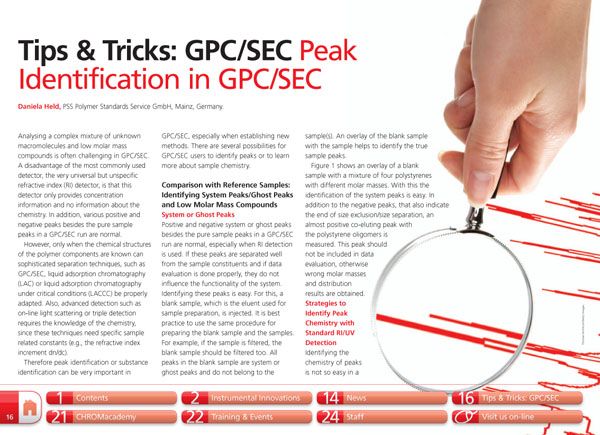Tips & Tricks: GPC/SEC Peak Identification in GPC/SEC
Peak identification or substance identification can be very important in GPC/SEC, especially when establishing new methods.
Analysing a complex mixture of unknown macromolecules and low molar mass compounds is often challenging in GPC/SEC. A disadvantage of the most commonly used detector, the very universal but unspecific refractive index (RI) detector, is that this detector only provides concentration information and no information about the chemistry. In addition, various positive and negative peaks besides the pure sample peaks in a GPC/SEC run are normal.However, only when the chemical structures of the polymer components are known can sophisticated separation techniques, such as GPC/SEC, liquid adsorption chromatography (LAC) or liquid adsorption chromatography under critical conditions (LACCC) be properly adapted. Also, advanced detection such as on-line light scattering or triple detection requires the knowledge of the chemistry, since these techniques need specific sample related constants (e.g., the refractive index increment dn/dc).Therefore peak identification or substance identification can be very important in GPC/SEC, especially when establishing new methods. There are several possibilities for GPC/SEC users to identify peaks or to learn more about sample chemistry.
Polysorbate Quantification and Degradation Analysis via LC and Charged Aerosol Detection
April 9th 2025Scientists from ThermoFisher Scientific published a review article in the Journal of Chromatography A that provided an overview of HPLC analysis using charged aerosol detection can help with polysorbate quantification.
Analyzing Vitamin K1 Levels in Vegetables Eaten by Warfarin Patients Using HPLC UV–vis
April 9th 2025Research conducted by the Universitas Padjadjaran (Sumedang, Indonesia) focused on the measurement of vitamin K1 in various vegetables (specifically lettuce, cabbage, napa cabbage, and spinach) that were ingested by patients using warfarin. High performance liquid chromatography (HPLC) equipped with an ultraviolet detector set at 245 nm was used as the analytical technique.
Removing Double-Stranded RNA Impurities Using Chromatography
April 8th 2025Researchers from Agency for Science, Technology and Research in Singapore recently published a review article exploring how chromatography can be used to remove double-stranded RNA impurities during mRNA therapeutics production.











